Array in C will also be explained as a technique of clubbing more than one entities of an identical kind into a bigger crew. Those entities or parts will also be of int, waft, char, double, or user-defined information varieties, like buildings. On the other hand, to be saved in combination in one array, the entire parts will have to be of the similar information kind. The weather are saved from left to proper, with the left-most index being the 0th index and the rightmost index being the (n-1) index.
Boost up your profession as a talented MERN Stack Developer by means of enrolling in a singular Complete Stack Developer – MERN Stack Grasp’s program. Get whole construction and trying out wisdom on the most recent applied sciences by means of choosing the MERN Stack Developer Direction. Touch us TODAY!
Arrays in C are of 2 varieties: Unmarried-dimensional arrays and multidimensional arrays.
- Unmarried-Dimensional Arrays: A single-dimensional array (1-D array) is the most straightforward type of array in C. It is composed of parts of an identical varieties, which will also be accessed via their indices.
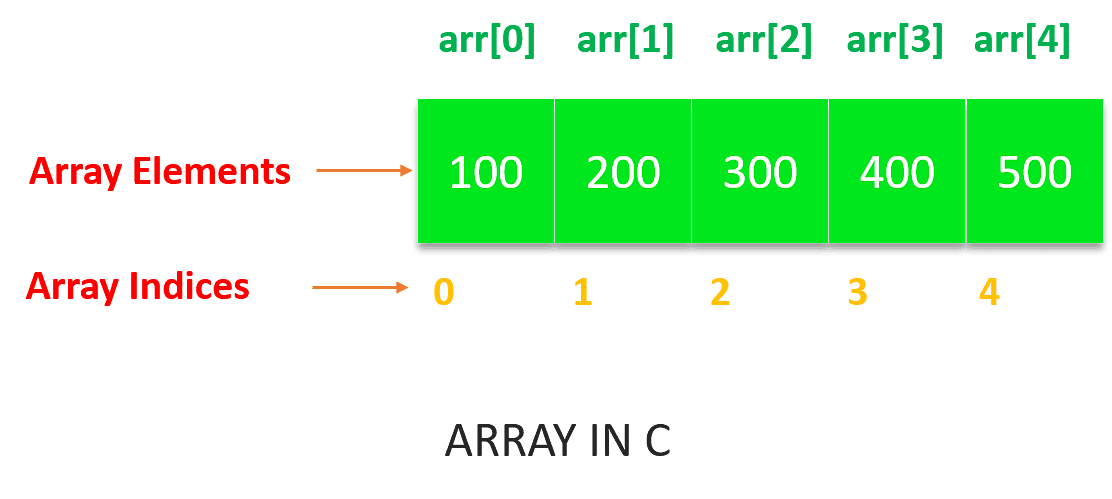
- Multi-dimensional Arrays: The commonest form of multi-dimensional array used within the C language is a 2-D array. On the other hand, the choice of dimensions will also be greater than 2 relying upon the compiler of the person’s gadget. Those arrays include parts which can be array themselves.
Why Do We Want Arrays?
If we’ve got a small choice of parts, we wish 3 variables; we will be able to claim them one at a time as var1, var2, and var3. But when we’ve got numerous variables, we will be able to retailer them in arrays.
Allow us to take a real-life instance. Think you need to make a program that prints 1-100 digits. Now, in C language, you’ll be able to accomplish that by means of 2 strategies. The primary one is to make 100 variables, retailer the numbers from 1-100 in the ones variables one at a time, after which print each and every digit. The second one manner is to create an array of length 100 and retailer the numbers in that array the use of a loop. Those digits will also be revealed the use of a unmarried loop in linear complexity. The second one manner is extra optimized and fascinating than the primary one as storing those values in one array is extra handy than growing 100 variables.
Change into job-ready for Programmer/ Developer roles these days with C Fundamentals On-line Instructional Direction for Newcomers!
Declaration and Initialization of Array in C
There are more than a few techniques through which an array will also be declared and initialized. You’ll claim an array of any information kind (i.e. int, waft, double, char) in C. The next techniques can be utilized to claim and initialize an array in C.
Array Declaration by means of Specifying the Dimension
Arrays will also be declared by means of specifying the scale or the choice of array parts. The array length specifies the utmost choice of parts the array can grasp. In the most recent model of C, you’ll be able to claim an array by means of specifying the scale on the time of the declaration, or you’ll be able to supply a user-specified length. The next syntax can be utilized to claim an array just by specifying its length.
// claim an array by means of specifying length in [].
int my_array1[20];
char my_array2[5];
// claim an array by means of specifying person explained length.
int length = 20;
int my_array3[size];
Symbol Reference
When an array is said with out allocating a worth, it retail outlets a rubbish worth. When you get entry to an uninitialized array worth, it’ll provide you with a rubbish worth, similar to any uninitialized variable.
Array Declaration by means of Initializing Components
An array will also be initialized on the time of its declaration. On this manner of array declaration, the compiler will allocate an array of length equivalent to the choice of the array parts. The next syntax can be utilized to claim and initialize an array on the identical time.
// initialize an array on the time of declaration.
int my_array[] = {100, 200, 300, 400, 500}
Within the above syntax, an array of five parts is created. Despite the fact that the array length has no longer been specified right here, the compiler will allocate an array of five integer parts.
Array Declaration by means of Specifying the Dimension and Initializing Components
An array may also be created by means of specifying the scale and assigning array parts on the time of declaration. This system of array advent isn’t like the former one. Right here, if the choice of initialized parts is not up to the scale of the array specified, then the remainder of the weather will robotically be initialized to 0 by means of the compiler. See the next syntax to know this.
// claim an array by means of specifying length and
// initializing on the time of declaration
int my_array1[5] = {100, 200, 300, 400, 500};
// my_array1 = {100, 200, 300, 400, 500}
// int my_array2[5] = {100, 200, 300};
// my_array2 = {100, 200, 300, 0, 0}Within the above array syntax, my_array1 is an array of length 5 with all 5 parts initialized. While, my_array2 is an array of length 5 with most effective 3 of its parts initialized. The rest two parts of the second one array will likely be initialized to 0 by means of the compiler.
Array Initialization The use of a Loop
An array may also be initialized the use of a loop. The loop iterates from 0 to (length – 1) for getting access to all indices of the array ranging from 0. The next syntax makes use of a “for loop” to initialize the array parts. That is the most typical solution to initialize an array in C.
// claim an array.
int my_array[5];
// initialize array the use of a "for" loop.
int i;
for(i = 0; i < 5; i++)
{
my_array[i] = 2 * i;
}
// my_array = {0, 2, 4, 6, 8}Within the above syntax, an array of length 5 is said first. The array is then initialized the use of a for loop that iterates over the array ranging from index 0 to (length – 1).
Newbie’s information to start out your profession with C programming abilities
|
Activity roles |
Wage (Reasonable) |
Certification Lessons |
Best firms hiring |
|
C Developer |
$98,000 (USA) | Rs.10LPA (IND) |
C Fundamentals On-line Instructional for Newcomers |
BOSCH Workforce, Capgemini, Amazon, Microsoft, Accenture, IBM, Meta, Adobe, Apple, Mozilla |
|
Backend Developer |
$105,000 (USA) | Rs.12LPA (IND) |
C Fundamentals On-line Instructional for Newcomers + Advent to C++ |
VISA, JP Morgan, Accenture, Wipro, Freshworks |
|
Fullstack Developer |
$180,000 (USA) | Rs.18LPA (IND) |
C Fundamentals On-line Instructional for Newcomers + Complete Stack Java Building Direction for Newcomers |
Meta, Netflix, Airbnb, Uber, Infosys,Wipro, Zomato, Swiggy, Ola, Paytm, Amazon, Microsoft |
Get admission to Array Components
Since an array is saved contiguously within the reminiscence, it has indices ranging from ”0” to “array_size – 1”, often referred to as zero-based indexing. This indexing represents the location within the array.
The array indices are used to get entry to any component of the array within the following approach:
array_name[index]
The index of the component to be accessed is specified inside of sq. brackets “[]”. The variability of the index is- integers within the vary [0, size).
Examples:
int my_array[6];
// get entry to 1st component
my_array[0] = 100;
// get entry to 4th component
my_array[2] = 300;
// get entry to final component
my_array[5] = 600;Enter and Output Array Components
Array values will also be saved by means of taking enter from the person and storing them within the array. The next instance illustrates this:
// enter an integer component and retailer it
// in 1st place of the array
scanf("%d", &my_array[0]);
// enter a waft component and retailer it
// in ith place of the array
scanf("%f", &my_array[i-1]);In a similar way, array parts may also be displayed within the output the use of the printf() manner. The index is specified, indicating the component’s place to be revealed. The next instance illustrates this:
// print the component saved at 1st place or 0th index
printf("%d", my_array[0]);
// print the component saved at ith place or (i - 1)th index
printf("%d", my_array[i-1]);Benefits of Array in C
Arrays have a really perfect importance within the C language. They supply a number of benefits to the programmers whilst programming. A few of them are:
- Arrays make the code extra optimized and blank since we will be able to retailer more than one parts in one array without delay, so we wouldn’t have to jot down or initialize them more than one instances.
- Each and every component will also be traversed in an array the use of a unmarried loop.
- Arrays make sorting a lot more uncomplicated. Components will also be looked after by means of writing a couple of traces of code.
- Any array component will also be accessed in any order both from the entrance or rear in O(1) time.
- Insertion or deletion of the weather will also be accomplished in linear complexity in an array.
Additionally Learn: Distinction Between Coding and Programming
Disadvantages of Array in C
Each and every benefit comes with some disadvantages as neatly. This stands true for arrays as neatly. Beneath are one of the most disadvantages of the array in C:
- Getting access to an array out of bounds: The primary downside of arrays is that they’re statically allotted. Which means their length can’t be larger or lowered as soon as their length is initialized. To grasp this level, imagine the instance given underneath:
#come with <stdio.h>
int major()
{
//mentioning the array of length 20
int my_array[20];
//initialising the array parts
for (int i = 0; i < 20; i++)
{
//i can be the worth of e
//very ith component of the array
my_array[i] = i;
}
// Print worth at index 5 of the array
printf("Part at index 5"
" is %dn",
my_array[5]);
// Print worth at index 13 of the array
printf("Part at index 13"
" is %dn",
my_array[13]);
// Print worth at index 21 of the array
printf("Part at index 21"
" is %d",
my_array[21]);
go back 0;
}
Within the above instance, the array arr’s preliminary worth is 20, so printing the values of parts as much as index 20 offers the specified output. But if we attempt to print the component on the twenty first index, it offers a rubbish worth. It is because the array used to be accessed out of the certain index.
This factor will also be resolved the use of malloc() and calloc() purposes. Those purposes allocate the reminiscence dynamically. We now have a loose() serve as that permits us to loose the undesirable reminiscence at our will. The underneath instance illustrates the similar:
#come with <stdio.h>
#come with <stdlib.h>
int major()
{
//*ptr will likely be storing the bottom
//deal with of the array parts
int *ptr;
int length, i;
// length of the array will likely be 5
length = 5;
printf("Dimension of the array is: %dn", length);
// allocating the array reminiscence
//dynamically the use of malloc()
ptr = (int *)malloc(length * sizeof(int));
// Checking whether or not the reminiscence has
//been effectively allotted by means of malloc
if (ptr == NULL)
{
printf("Reminiscence has no longer been allotted allocatedn");
go out(0);
}
else
{
// Reminiscence has been effectively allotted
printf("Reminiscence has been allotted successfullyn");
// initializing the array parts
for (i = 0; i < length; ++i)
{
ptr[i] = i + 1;
}
// Print the weather of the array
printf("The weather of the array are: ");
for (i = 0; i < length; ++i)
{
printf("%d ", ptr[i]);
}
}
go back 0;
}
- Homogeneity: We will retailer just a unmarried form of component within the array, i.e., homogeneous arrays. We will no longer use it as a template. As an example, if the array information kind is char, most effective characters will also be saved within the array. Looking to retailer integers or every other component of a distinct information kind will throw an error. To grasp this level, imagine the instance given underneath:
#come with <stdio.h>
int major()
{
// such declaration will throw
// Compilation Error
int my_array[6] = {1, 2, "mango", 4, 5, 6.2};
int i;
printf("Components of the array are: ");
for (i = 0; i < 6; i++)
{
printf("%d ", my_array[i]);
}
go back 0;
}
Within the above instance, the array’s information kind is int. On the other hand, after we attempt to claim string and waft values to the array, it throws a compilation error.
This factor will also be resolved by means of making a construction to retailer heterogeneous (non-homogeneous) values. Believe the underneath instance to know this idea:
#come with <stdio.h>
// create a construction
struct instance
{
int fruit_quant;
waft fruit_rate;
char fruit_name[30];
};
int major()
{
// s1 - object of the construction
struct instance s1 = {10, 90.45, "Mango"};
// getting access to construction individuals
// the use of construction object
printf("%dn", s1.fruit_quant);
printf("%fn", s1.fruit_rate);
int i;
for (i = 0; s1.fruit_name[i] != '�'; i++)
{
printf("%c", s1.fruit_name[i]);
}
go back 0;
}
Spice up your profession with our Complete Stack Developer – MERN Stack Grasp’s program! Achieve in-depth experience in construction and trying out with the most recent applied sciences. Sign up these days and turn into a talented MERN Stack Developer!
The next techniques illustrate declaration, initialization, enter/output operations, and fundamental operations like insertion, deletion, sorting, and looking within the 1-D array in C.
Instance 1: Array Declaration, Enter, and Output
#come with <stdio.h>
int major()
{
// claim an array.
int my_array[6];
printf("Input array parts:n");
// enter array parts.
int i;
for (i = 0; i < 6; i++)
{
scanf("%d", &my_array[i]);
}
printf("nArray parts are:n");
// print array parts.
for (i = 0; i <= 5; i++)
{
printf("%d ", my_array[i]);
}
go back 0;
}
Within the above instance, an integer array of length 6 is said. This array can grasp at maximum 6 integer parts. A “for loop” is used to enter the array parts from the person. In a similar way, a “for loop” prints those parts within the output. Each instances, the loop runs from 0 to five to iterate over the entire array parts.
Instance 2: Insertion and Deletion in an Array.
#come with <stdio.h>
int major()
{
int i;
// initialize an array.
int my_array[10] = {11, 6, 10, 50, 32, 56, 15, 98, 43, 22};
// enter index the place the component is to be inserted.
int pos;
printf("Input the location: ");
scanf("%d", &pos);
// enter the component to be inserted.
int component;
printf("Input the component: ");
scanf("%d", &component);
if (pos > 10)
{
printf("Enter is invalid !");
}
else
{
// proper moving array parts.
for (i = 9; i >= pos - 1; i--)
my_array[i + 1] = my_array[i];
// insert the component at "pos".
my_array[pos - 1] = component;
printf("Array after insertion is:n");
// print array parts.
for (i = 0; i <= 10; i++)
printf("% d ", my_array[i]);
}
go back 0;
}
Within the above instance, a component that must be inserted is taken as enter. The placement the place this component is to be saved could also be taken as enter. The array parts are shifted to the proper to create space for the brand new component. After insertion, the scale of the array is incremented.
Instance 3: Sorting Components of an Array
#come with <stdio.h>
int major()
{
int i, j, temp;
// initialize an array.
int my_array[10] = {11, 6, 10, 50, 32, 56, 15, 98, 43, 22};
// print unsorted array.
printf("Authentic array is: n");
for (i = 0; i < 10; i++)
{
printf("%d ", my_array[i]);
}
// type the array parts in descending order.
for (i = 0; i < 10; i++)
{
for (j = i + 1; j < 10; j++)
{
if (my_array[j] > my_array[i])
{
temp = my_array[i];
my_array[i] = my_array[j];
my_array[j] = temp;
}
}
}
// print the looked after parts.
printf("nnSorted array in descending order is: n");
for (i = 0; i < 10; i++)
{
printf("%d ", my_array[i]);
}
go back 0;
}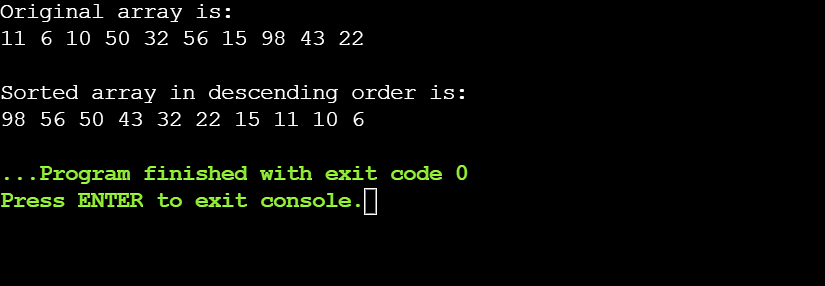
Within the above instance, an array of length 10 is initialized. The array parts are looked after in descending order the use of the bubble type set of rules.
One Dimensional Array in C
A one-dimensional array in C is a selection of parts of the similar information kind, saved sequentially in reminiscence. Every component within the array is known by means of an index, ranging from 0. Arrays are used to retailer more than one values in one variable reasonably than mentioning separate variables for each and every worth.
Syntax
data_type array_name[size];
Getting access to Components
Components are accessed the use of their index:
numbers[0] = 10; // First componentInstance
#come with <stdio.h>
int major() {
int numbers[5] = {1, 2, 3, 4, 5};
for (int i = 0; i < 5; i++) {
printf("%d ", numbers[i]);
}
go back 0;
}On this instance, a one-dimensional array quantity is initialized with 5 values, and a loop is used to print each and every component.
2 Dimensional Array in C
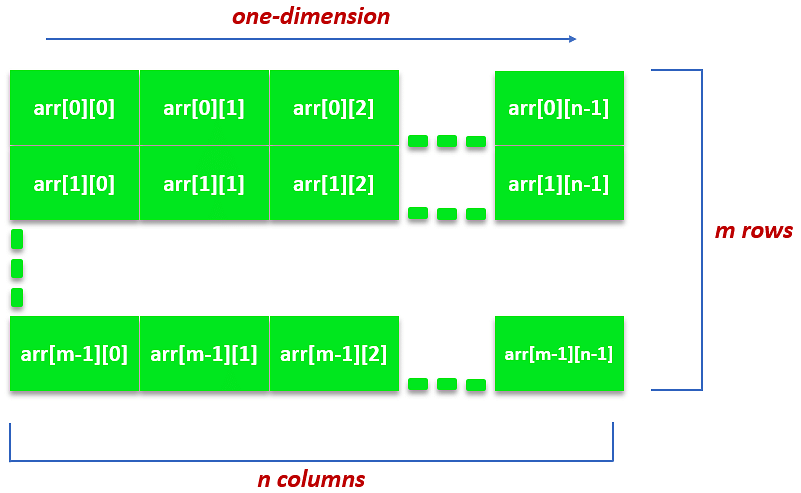
A 2-dimensional array or 2-D array is the most straightforward type of multi-dimensional array in C. Every component in a 2-D array will also be represented as a separate 1-D array. A 2-D array comprises a definite choice of rows and columns and the full choice of array parts will also be discovered by means of multiplying the choice of rows and columns. As an example, if the array is my_array[2][3], then the full choice of parts within the array is 6.
A matrix is claimed to be a sq. matrix when the choice of rows is the same as the choice of columns. When the choice of rows differs from the choice of columns, the matrix is claimed to be a rectangle matrix. Processing a 2-D array calls for a nested loop. The outer loop indicates the choice of rows and the interior loop indicates the column of parts of each and every row. On the other hand, the importance of the outer and interior loops will also be interchanged relying on whether or not the person desires a row order matrix or a column order matrix.
Declaration of 2-D Array in C
Syntax to Claim a 2-Dimensional Array in C:
// mentioning a 2-d array
dataType arrayName[no_of_rows][no_of_columns];
Description of the syntax:
- dataType: This information kind specifies the kind of parts to be saved within the array. It may be int, waft, double, or char.
- arrayName: That is the identify of the array. To specify the identify of an array, you should apply the similar regulations appropriate whilst mentioning a standard variable in C.
- no_of_rows: That is the primary size of the array. It’s an integer specifying the choice of rows the array will grasp.
- no_of_columns: That is the second one size of the array. It’s an integer worth representing the choice of columns of the array.
Examples
// 5 x 10 matrix.
int my_array1[5][10];
// 3 x 3 sq. matrix.
waft my_array2[3][3];
// 2 x 1 matrix.
char my_array3[2][1];Observe: The whole choice of parts that the array can grasp is (no_of_rows * no_of_columns). As an example, an array arr[2][4] will have at maximum 8 parts.
Initialization of 2-D Array in C
In 1-D arrays, you’ll be able to skip specifying its length when an array is initialized on the time of its declaration. On the other hand, this situation is other with 2-D arrays. Simplest the primary size will also be skipped, and the second one is obligatory at initialization.
The next techniques can be utilized to initialize a 2-D array in C:
- The traditional approach: That is the most typical solution to initialize an array in C. 1-D arrays equivalent to the choice of the primary size (or rows) are created having parts equivalent to the choice of the second one size (or columns).
Instance
int my_array[3][2] = {
{11, 12},
{21, 22},
{31, 32}
};
Within the above instance, there are 3 1-D arrays (3 = choice of rows) with 2 parts each and every (2 = choice of columns).
- The compact approach: On this manner, all array parts are written in the similar line separated by means of commas. It seems like a 1-D array initialization. This fashion isn’t beneficial because the initialized array has much less clarity.
Instance
int my_array[3][2] = {11, 12, 21, 22, 31, 32};All array parts are written inside of a unmarried pair of braces “{}” within the above instance. This sort of initialization is much less readable.
- The use of a loop: Just like the 1-D arrays, 2-D arrays may also be initialized the use of a loop. Essentially the most regularly used loop is the “for loop”. Two nested loops are required to initialize the array.
Instance
int my_array[2][3];
int i, j;
// The primary loop runs until the choice of rows.
for(i = 0; i < 2; i++)
{
// 2d loop runs until choice of columns.
for (j = 0; j < 3; j++)
{
my_array[i][j] = i + j;
}
}
/* my_array = {
{0, 1, 2},
{1, 2, 3}
} */Within the above instance, two “for loops” initialize a 2-D array. The primary loop runs from 0 to the choice of rows. The second one loop runs from 0 to the choice of columns.
In a position to grasp the MERN Stack? Sign up for our Complete Stack Developer – MERN Stack Grasp’s program and boost up your profession with complete construction and trying out abilities. Touch us these days to get began!
Issues to Keep in mind Whilst 2-D Array Initialization
The second one size is obligatory whilst mentioning a 2-D array, while the primary will also be non-compulsory. The next examples illustrate the imaginable errors that may be made whilst initializing a 2-D array in C:
// legitimate
int my_array[3][3] = {10, 20, 30 ,40, 50, 60, 70, 70, 80, 90}
// legitimate
int my_array[][3] = {10, 20, 30 ,40, 50, 60, 70, 70, 80, 90}
// invalid: 2d size should be specified.
int my_array[][] = {10, 20, 30 ,40, 50, 60, 70, 70, 80, 90}
// invalid: 2d size should be specified.
int my_array[3][] = {10, 20, 30 ,40, 50, 60, 70, 70, 80, 90}Examples of 2-D Array in C
The next examples illustrate the elemental implementation of a 2-D array, together with enter and output operations in a 2-D matrix and discovering the matrix’s transpose.
Instance 1: 2-D Array Declaration, Enter, and Output.
#come with <stdio.h>
int major()
{
// mentioning and initializing the 2-D array.
// 2-D array with 5 rows and a couple of columns.
int x[5][2] = {{0, 1}, {2, 3}, {4, 5}, {6, 7}, {8, 9}};
int i, j;
// print the worth of each and every array component.
// outer loop- for rows.
for (i = 0; i < 5; i++)
{
// interior loop- for columns.
for (j = 0; j < 2; j++)
{
printf("Part at x[ %d", i);
printf("][ %d", j);
printf("] :");
printf("%d", x[i][j]);
printf("n");
}
}
go back 0;
}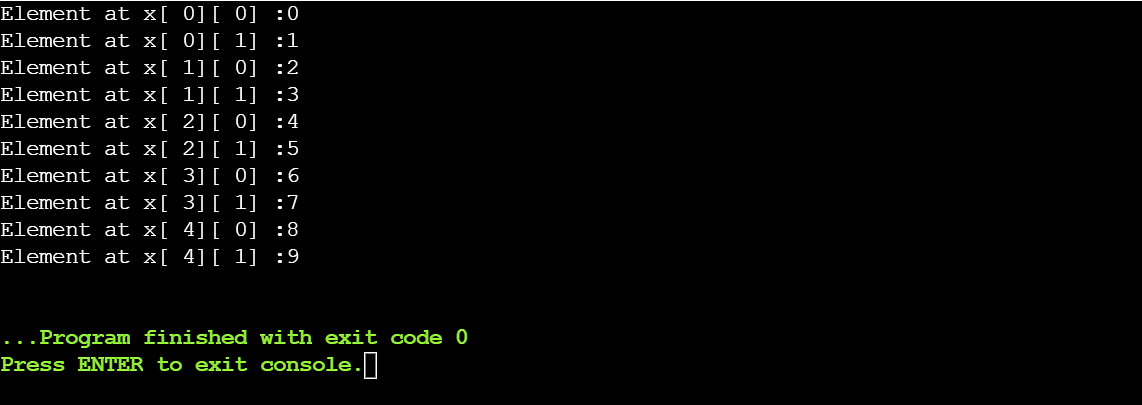
Within the following instance, a 2-D array of five rows and a couple of columns has been declared and initialized. For printing, we’re the use of two “for loops.” The outer “for loop” prints the rows, whilst the interior “for loop” prints columns for each and every row.
Instance 2: Discovering Sum and Manufactured from Two 2 Matrices
#come with <stdio.h>
int major()
{
// mentioning arr1 and arr2.
int arr1[2][2], arr2[2][2];
int sum[2][2], product[2][2];
// studying enter for arr1 from the person.
printf("Input the weather of arr1 : n");
for (int i = 0; i < 2; i++)
{
for (int j = 0; j < 2; j++)
{
printf("arr1[%d][%d] :", i, j);
scanf("%d", &arr1[i][j]);
}
printf("n");
}
// studying enter for arr2 from the person.
printf("Input the weather of arr2: n");
for (int i = 0; i < 2; i++)
{
for (int j = 0; j < 2; j++)
{
printf("arr2[%d][%d] :", i, j);
scanf("%d", &arr2[i][j]);
}
printf("n");
}
// including the corresponding array parts.
printf("Sum array is : n");
for (int i = 0; i < 2; i++)
{
for (int j = 0; j < 2; j++)
{
sum[i][j] = arr1[i][j] + arr2[i][j];
//print the sum array
printf("%dt", sum[i][j]);
}
printf("n");
}
// multiplying the corresponding array parts.
printf("Product array is : n");
for (int i = 0; i < 2; i++)
{
for (int j = 0; j < 2; j++)
{
product[i][j] = arr1[i][j] * arr2[i][j];
// print the product array.
printf("%dt", product[i][j]);
}
printf("n");
}
go back 0;
}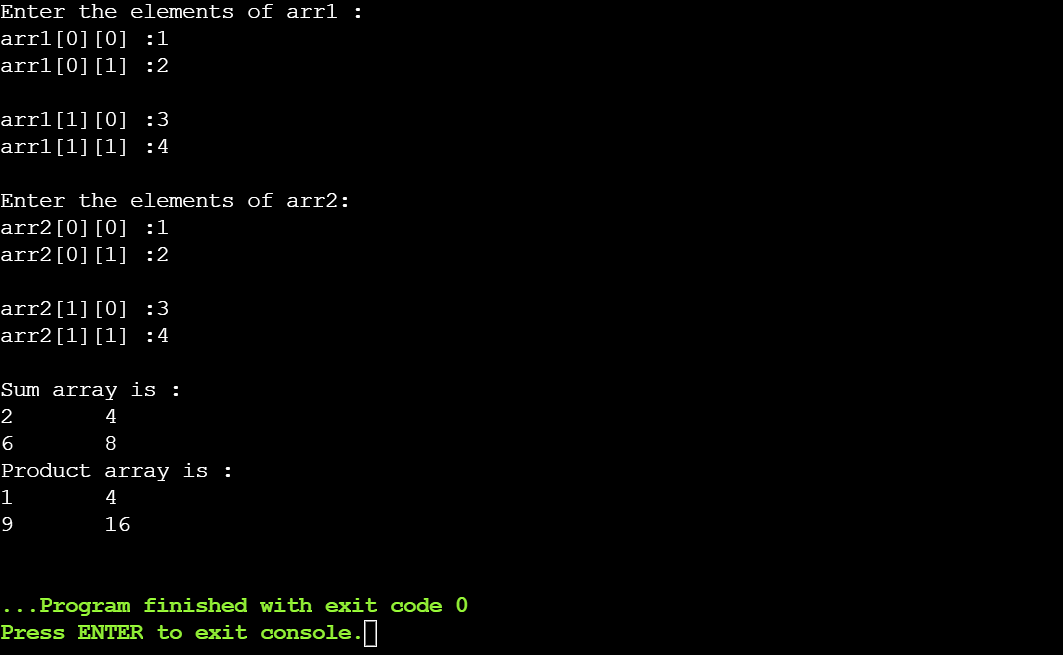
For locating the addition of 2 matrices, the choice of rows and columns will have to be the similar in each matrices. For locating the product of 2 matrices, the choice of columns within the first matrix will have to be the similar because the choice of rows in the second one matrix.
A resultant matrix of the similar order is said to get the sum of the 2 matrices. To get the made from the 2 matrices, a resultant matrix having rows equivalent to the primary matrix and columns equivalent to the second one matrix is said.
Instance 3: Transpose of a Matrix
Sq. Matrix
#come with <stdio.h>
int major()
{
// mentioning the matrices.
int arr[10][10], transpose[10][10];
// studying the enter from the person.
printf("Input parts of the arrn");
for (int i = 0; i < 2; i++)
for (int j = 0; j < 2; j++)
scanf("%d", &arr[i][j]);
// reproduction the array component into any other component.
for (int i = 0; i < 2; i++
for (int j = 0; j < 2; j++)
transpose[j][i] = arr[i][j];
printf("Transpose of the arr:n");
//print the transpose of the arr
for (int i = 0; i < 2; i++)
{
for (int j = 0; j < 2; j++)
printf("%dt", transpose[i][j]);
printf("n");
}
go back 0;
}
Within the above instance, the transpose of a sq. matrix is outlined. For printing the transpose of the matrix, first, the matrix parts are copied in any other matrix after which the rows and the columns of the copied matrix are reversed.
Oblong Matrix
#come with <stdio.h>
int major()
{
// mentioning the matrices.
int arr[10][10], transpose[10][10];
// studying the enter from the person.
printf("Input parts of the arrn");
for (int i = 0; i < 2; i++)
{
for (int j = 0; j < 3; j++)
scanf("%d", &arr[i][j]);
}
// reproduction the array component into any other component.
for (int i = 0; i < 2; i++)
{
for (int j = 0; j < 3; j++)
transpose[j][i] = arr[i][j];
}
printf("Transpose of the arr:n");
// print the transpose of the array.
for (int i = 0; i < 3; i++)
{
for (int j = 0; j < 2; j++)
printf("%dt", transpose[i][j]);
printf("n");
}
go back 0;
}
Within the above instance, the matrix is a rectangle, this means that that the choice of rows isn’t equivalent to the choice of columns. The common sense is equal to that within the earlier instance.
Instance 4: Test if the Given Matrix is Sparse or No longer
#come with <stdio.h>
#come with <stdlib.h>
int major()
{
int row, col, a[10][10], rely = 0;
// learn the choice of rows and columns from the person.
printf("Input the choice of rows: n");
scanf("%d", &row);
printf("Input the choice of columns: n");
scanf("%d", &col);
// learn the weather of the matrix from the person.
printf("Input the matrix parts: n");
for (int i = 0; i < row; i++)
{
for (int j = 0; j < col; j++)
{
scanf("%d", &a[i][j]);
}
}
// print the matrix.
printf("Matrix is:n");
for (int i = 0; i < row; i++)
{
for (int j = 0; j < col; j++)
{
printf("%dt", a[i][j]);
}
printf("n");
}
// take a look at if the matrix is sparse or no longer.
for (int i = 0; i < row; i++)
{
for (int j = 0; j < col; j++)
{
if (a[i][j] == 0)
rely++;
}
}
if (rely > ((row * col) / 2))
printf("Matrix is a sparse matrix n");
else
printf("Matrix isn't sparse matrixn");
}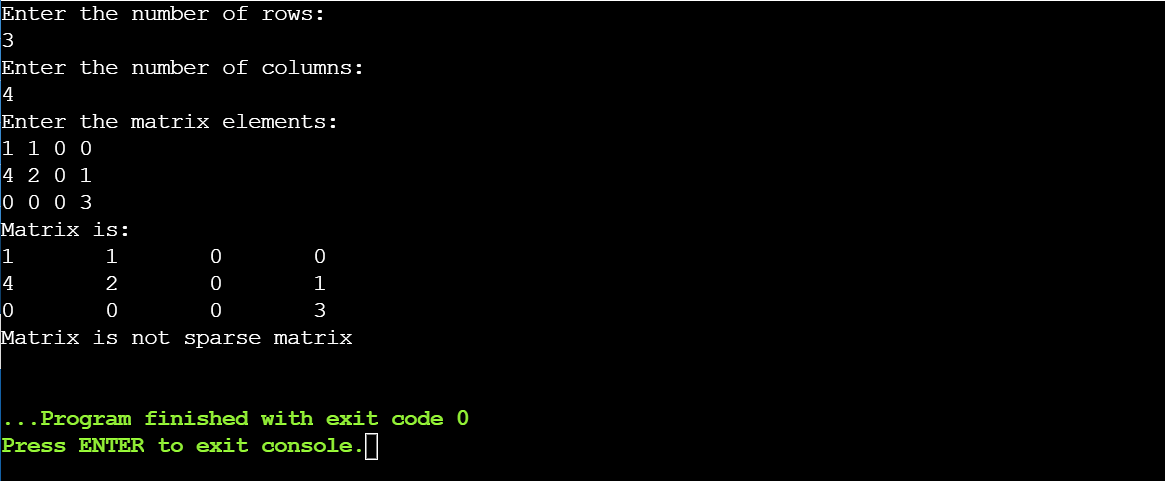
Within the above instance, it’s checked whether or not the matrix is sparse or no longer. A sparse matrix is one through which 0’s is larger than the non-zero parts. A counter is maintained to rely the choice of 0’s. After all, the rely of 0’s is when put next with part the full choice of parts within the matrix.
Arrays vs. Tips
Arrays can behave like tips in lots of instances, corresponding to when an array is handed to a serve as, which treats it as a pointer. Additionally, pointer mathematics applies to arrays. On the other hand, those two range from each and every different in some ways. The next comparability chart summarizes the important thing variations between a pointer and an array in C.
COMPARISON BASIS |
ARRAY |
POINTER |
|
DEFINITION |
An array retail outlets a number of values of a an identical kind. |
A pointer retail outlets the deal with or reminiscence location of a variable. |
|
SYNTAX |
kind array_name[size]; |
Kind *ptr_name; |
|
MEMORY ALLOCATION |
Contiguous or sequential reminiscence is allotted to the weather of an array. |
A pointer will also be allotted to any random to be had reminiscence. |
|
MEMORY SPACE |
Arrays are static, so their length can’t be altered. |
A pointer is dynamic, so the reminiscence length will also be both altered and even freed. |
|
NO. OF VALUES STORED |
A unmarried array can retailer numerous parts. |
A pointer can level to just one variable’s deal with. |
|
TYPE |
The knowledge form of the array is decided by means of the kind of parts saved in it. |
The knowledge form of a pointer is decided by means of the kind of the variable whose reminiscence location it’s pointing to. |
|
Sizeof() Operator |
When an array is handed to the sizeof() operator, the blended length of the entire saved parts is returned. |
When a pointer is handed to the sizeof() operator, the scale of the pointer is outlined (normally 8). This length is similar for any form of pointer. |
|
COMPILE-TIME/ RUN-TIME |
Reminiscence is allotted to an array all over the compilation.
|
Reminiscence is allotted to a pointer all over the run time of this system. |
Passing an Array to a Serve as
When an array in C is handed to a serve as, most effective the deal with of the array’s first component is handed to the serve as. And being contiguous, the entire array will also be accessed by means of the serve as the use of the deal with of the primary component.
Passing an Array Part to a Serve as
We will cross a unmarried array component to a serve as as its argument. The next examples illustrate this. Right here, we’ve got made a serve as that prints the component handed to it.
#come with<stdio.h>
//serve as having an int kind parameter
void func(int a)
{
printf("Array component handed to the serve as is: %d", a);
}
int major()
{
//initialized 1-D array
int arr[] = { 1, 2, 3, 4, 5 };
//serve as name
func(arr[2]); //passing arr[2] i.e., 3 to the func.
go back 0;
}
Passing a 1-D Array to a Serve as
Within the above segment, an array component used to be handed to a serve as. On this segment, we’re going to take a look at how a 1-D array will also be handed to a serve as via a easy instance given underneath. Right here, a serve as has been made to which we’re passing an array and its length, and the serve as returns the utmost component of that array.
#come with<stdio.h>
// serve as in finding the best array elemen
int most(int arr[], int length)
{
int i;
int massive = arr[0];
for(i = 0; i<length; i++)
{
if(arr[i]>massive)
{
massive = arr [i];
}
}
go back massive;
}
int major()
{
int outcome;
// 1-D array initialization
int arr[] = {100, 2, 1, 120, 55, 41};
int length = sizeof(arr) / sizeof(int);
// serve as name
outcome = most(arr, length); // 1-D array is handed to the serve as.
printf("The best array component is: %d", outcome);
go back 0;
}
Passing a Multidimensional Array to a Serve as
We will additionally cross a matrix or a 2-D array to a matrix. The instance underneath illustrates the place a matrix is handed to a serve as, and the serve as prints that matrix.
#come with<stdio.h>
// serve as to print the matrix parts
void printMatrix(int arr[3][3])
{
int i, j;
printf("The Matrix thus shaped is: n");
for (i = 0; i < 3; ++i)
{
// trade the road
printf("n");
for (j = 0; j < 3; ++j)
{
printf("%dt", arr[i][j]);
}
}
}
int major()
{
int arr[3][3], i, j;
// studying enter from person
printf("Input the weather: n");
for (i = 0; i < 3; ++i)
{
for (j = 0; j < 3; ++j)
{
scanf("%d", &arr[i][j]);
}
}
// passing 2-D array or a
// Matrix as an issue
printMatrix(arr);
go back 0;
}
Boost up your profession as a talented MERN Stack Developer by means of enrolling in a singular Complete Stack Developer – MERN Stack Grasp’s program. Get whole construction and trying out wisdom on the most recent applied sciences by means of choosing the MERN Stack Developer Direction. Touch us TODAY!
Tips that could Array
As we mentioned within the previous segment, arrays and tips are comparable in C. On this segment, we can talk about how a pointer will also be declared to retailer an array’s deal with.
The next benefits are completed by means of mentioning a pointer to an array:
- The array parts can now be accessed in more than one techniques.
- The time and area complexity of this system will also be lowered.
- Arrays will also be manipulated extra successfully.
#come with<stdio.h>
int major()
{
int i;
int my_array[8] = {10, 20, 30, 40, 50, 60, 70, 80};
// claim a pointer pointing to the above array.
int *my_ptr = my_array;
my_ptr = my_array;
// get entry to an array component the use of the pointer.
*(my_ptr + 1) = 100;
// print array parts the use of the pointer.
printf( "Array parts are: n");
for ( i = 0; i < 8; i++ ) {
printf("*(my_ptr + %d) = %dn", i, *(my_ptr + i) );
}
go back 0;
}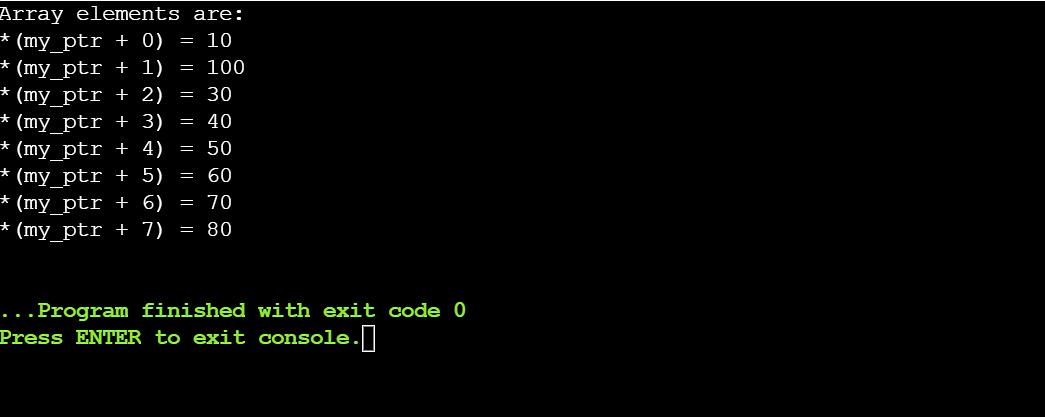
Within the above program, a pointer *my_ptr is pointing to the array my_array. This merely implies that the deal with of the array’s first component (i.e. my_array[0]) is saved within the pointer. The pointer now has get entry to to all parts of the array.
That used to be all about Array in C.
Ultimate Ideas!
To sum up, this text taught you the concept that of arrays in C. You began with a short lived creation to the array information construction and progressively moved on to speak about their wishes, benefits, and drawbacks. Subsequent, you noticed the other ways to claim and initialize arrays in C.
Subsequent, you discovered to get entry to an array and enter or output parts to/from an array. Transferring forward, you noticed some examples of 1D and 2D arrays. After all, you discovered the right way to cross an array to a serve as, an idea known as tips to an array, and the variations between an array and a pointer.
Why prevent right here? To be told full-stack internet construction, you will have to take a look at Simplilearn’s Complete Stack Developer – MERN Stack’ route. This complete program will equip you with in-depth wisdom and hands-on revel in in development dynamic internet programs the use of MongoDB, Specific.js, React, and Node.js. You can learn to create powerful server-side programs, broaden responsive front-end interfaces, and arrange information successfully with MongoDB. The route additionally covers crucial equipment and practices corresponding to model keep watch over with Git, deploying programs with Docker, and enforcing RESTful APIs. It is a perfect selection for aspiring full-stack builders having a look to grasp the MERN stack and advance their careers in internet construction. If in case you have a knack for studying new classes, you will have to take a look at Simplilearn’s whole listing of loose classes.
FAQs
1. What’s array in C?
An array in C is a selection of parts of the similar information kind, saved sequentially in reminiscence. It permits more than one values to be saved in one variable, accessed the use of an index.
2. What are the three not unusual varieties of arrays?
The 3 not unusual varieties of arrays are:
-
- One-dimensional array
- Two-dimensional array (matrix)
- Multi-dimensional array
3. What’s an array in C programming?
In C programming, an array is a knowledge construction used to retailer a fixed-size collection of parts of the similar information kind, accessed the use of indices ranging from 0.
4. What are array houses?
Array houses come with constant length, contiguous reminiscence allocation, homogeneous information kind, and zero-based indexing for component get entry to.
5. How you can initialize an array in C?
Arrays will also be initialized in C by means of specifying values inside of curly braces, like:
6. What are array strategies?
In C, arrays don’t have integrated strategies like higher-level languages. On the other hand, sorting, looking, and traversing are not unusual array manipulations accomplished via purposes.
7. What’s an array serve as?
An array serve as both takes an array as an issue or returns an array, enabling more than a few operations like traversing, editing, or processing array parts.
supply: www.simplilearn.com












